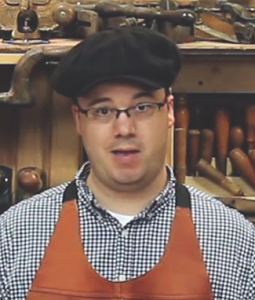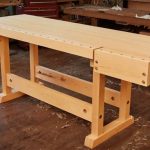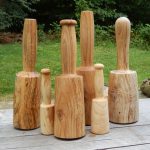We may receive a commission when you use our affiliate links. However, this does not impact our recommendations.
 James Hamilton is the mastermind behind the popular Stumpy Nubs web site, which offers a range of online videos dedicated to spending some quality time in the shop, with a particular emphasis on creating homemade woodworking machines, tools and jigs. Hamilton is constantly looking for ways to streamline, organize and improve workshops – and makes it his mission to help others do the same. His new book, “The Homemade Workshop,” will be published in October 2015, and he will be teaching at Woodworking in America in September. Hamilton was kind enough to take a few moments from his busy schedule – but not from his breakfast – to answer a few questions.
James Hamilton is the mastermind behind the popular Stumpy Nubs web site, which offers a range of online videos dedicated to spending some quality time in the shop, with a particular emphasis on creating homemade woodworking machines, tools and jigs. Hamilton is constantly looking for ways to streamline, organize and improve workshops – and makes it his mission to help others do the same. His new book, “The Homemade Workshop,” will be published in October 2015, and he will be teaching at Woodworking in America in September. Hamilton was kind enough to take a few moments from his busy schedule – but not from his breakfast – to answer a few questions.
With your web site and online shows, you have a ton of irons in the fire. What would you say you spend most of your time working on?
This year has been crazy, everything is out of whack! Between writing the new book, classes to teach at Woodworking in America and for Popular Woodworking University and other commitments, it seems like I live at my desk. But normally I spend half my time in the shop working on new ideas, and the other half of my time writing, filming and editing to share those ideas with our audience. I also spend a great deal of time eating. In fact, you don’t mind if I eat a donut during this interview, do you?
Go for it. I’m having a bagel, myself. So, what do you wish you had more time to work on?
Building furniture. I’m an artist at heart, or at least I like to think that I am. I painted portraits when I was younger and getting more involved in woodworking was supposed to be another way for me to indulge my passion for art. My head is full of ideas that I would love to create, but I simply don’t have time. Don’t get me wrong, I love what I do. Designing jigs and tools, teaching woodworking techniques and generally screwing around for an audience is a great gig. But sometimes I feel like I’ll explode if I don’t get a chance to create something that at least I think is beautiful or truly unique. I have the ideas, I have some amount of skill, I definitely have the tools, I just lack the time.
 Speaking of things that took up a bunch of your time, your book, “The Homemade Workshop,” will be published in the fall. What do you hope to accomplish with the book? How does it dovetail with your online efforts and your overall mission?
Speaking of things that took up a bunch of your time, your book, “The Homemade Workshop,” will be published in the fall. What do you hope to accomplish with the book? How does it dovetail with your online efforts and your overall mission?
Imagine the way you feel after building a piece of furniture. If it comes out looking good you take a lot of pride in it, and rightly so. (Unless it’s ugly. If that’s the case you’ll have to ask Chris Schwarz what he does with his furniture… JUST KIDDING! Settle down, folks…) Now double that and you come close to understanding how it feels to build that same piece of furniture using tools you also built yourself. That’s what the book is about, challenging yourself to make something you may not have tried before, and then using that homemade machine to improve your workshop. Our audience is made up of people looking to save money by making their own tools, people who want to try out a truly unique project, and people who realize that homemade tools can include amazing features that simply aren’t available on the commercial market. That’s who we try to reach with our online efforts, and that’s who we hope to reach with the new book.
How has Stumpy Nubs evolved over time?
When I first started producing woodworking content online I had an ambitious plan. I set out to create the type of woodworking show I wanted to watch. TV woodworking shows are great, but they’re largely the same. You watch a guy with a big smile build a piece of furniture that you will never build yourself, with tools that you could never afford. I wanted a show with a mix of truly useful information for everyday woodworkers. It was divided into segments: you had your woodworking tips and tricks, your skills education, a little entertainment to keep things fun, and a jig project that would improve the viewer’s shop. I called that show “Blue Collar Woodworking” and I loved making it.
But, despite my overly ambitious efforts to change the world, YouTube is not television. People don’t go there to watch a 40 minute show. After five or 10 minutes, they move on to the next thing. That’s the nature of the Internet. I still think that will change over time as more people begin consuming all of their television online. But it’s not here yet. So I realized that if I was going to make a difference in the woodworking world, I had to completely change the way I reached out to people. Today we teach woodworking in bite-sized pieces that people can select according to their tastes. It’s like a buffet, and who doesn’t like buffets, eh? But my original vision is still sitting in the corner of my mind, patiently waiting for the right time to make a comeback.
Is there anything you wish you could help your fans understand early on that took you a long time to discover?
Master the tools you have! As a stage-four tool nut, I’ve wasted small fortunes on the next great tool that will “revolutionize my workshop.” It makes me sick to think of all the donuts I could have bought with the money I’ve wasted. You can do amazing things with just a few tools if you really know how to use them. A table saw, for example, can do everything from stock prep to dimensioning to complex joinery and profile shaping. It can be a sander, an edge jointer, I’ve even seen people use it as a lathe. A table saw alone can do far more than many woodworkers have ever considered. All you need is the education, and a few jigs. (By the way, I’m teaching a class for Popular Woodworking University on how to do many of these things with a table saw in the fall. How’s that for a shameless plug?)
If you were on a desert island and could only have one woodworking machine – and let’s say there just happens to be a palm tree with an electrical outlet that mysteriously supplies sufficient power – what would machine would you choose?
A table saw. Like I said, it can do it all! But here’s the catch… Inside the table saw I’ve smuggled a collection of hand tools, a case of IPA and a Tom Waits CD (if the tree has power, maybe it has a stereo system too). Sorry to blow your “one machine” plan to smithereens, but that’s how I roll.
Well, that scenario was sort of like “LOST” for woodworkers, so really we could just make it up as we go along – I’m pretty sure that’s what J.J. Abrams did. What are you looking forward to most at WIA?
The end. Honestly, you wouldn’t believe how nervous I am. I’m on a teaching schedule that includes people like Roy Underhill and Tom Fidgen, for goodness sakes! I’m supposed to teach beside David Marks and Chris Schwarz (who probably won’t speak to me after that ugly furniture joke!). Seriously, every woodworker on the schedule is someone I look up to. So the pressure is enormous. But I know the class I am teaching is going to be awesome because I really know my stuff, and there has never been anything like it at Woodworking in America. I hope people come see it, because this may be a onetime only class! I am also planning to bribe them with a special gift for all of the students who attend, so there’s that too…
 Don’t miss James Hamilton at Woodworking In America, September 25-27, 2015. Click to learn more about WIA.
Don’t miss James Hamilton at Woodworking In America, September 25-27, 2015. Click to learn more about WIA.
Here are some supplies and tools we find essential in our everyday work around the shop. We may receive a commission from sales referred by our links; however, we have carefully selected these products for their usefulness and quality.








